An introduction to Interspecific hybrids – by Helen Marriott
Prologue
Following an introduction to interspecifics at the 21 August, 2009 meeting of the Melbourne Clivia Group (MCG), the text below was published in the club’s subsequent newsletter in Oct 2009 (Vol. 2.5). As I re-read the text nine years later in 2018, I feel that the basic outline concerning interspecifics still stands today, though in the intervening years we have seen much more breeding, especially in South Africa and on a smaller scale in Japan and elsewhere, of interspecifics. As a result, many more examples could be given of outstanding plants, though most of those specifically referred to below have stood the test of time. In the interim, the breeding of new interspecific hybrids where at least one parent is an interspecific has increased substantially. Furthermore, more resources on Clivia have been published. The original 2009 text has not been updated with such content but basically follows the earlier paper with only minor adjustments and with several more photos added.
Introduction
In contrast to intraspecific hybrids which are hybrids between different forms of one Clivia species, commonly, but not exclusively C. miniata, interspecific hybrids are hybrids between different Clivia species (Duncan 2008 p.17). Among the various exciting prospects for the development of the genus Clivia in the coming years, surely one must be the further advancement of Clivia interspecific hybrids involving crossings of the existing species – C. caulescens, C. gardenii, C. miniata, C. mirabilis, C. nobilis, and C. robusta. To start with, I recommend a visit to some websites that contain photos of interspecific hybrids. A list is given at the end of this text, but for seeing photos of the latest hybrids one of the two email groups/forums is highly recommended as well as the gallery on the MCG website.
Clivia x cyrtanthiflora is the name given to the first recorded hybrid bred in Europe in the 19th century between C. nobilis and C. miniata. This hybrid (or later generations of it) seems to have arrived in Australia relatively early in the country’s history of the introduction of Clivia and can be found in large massed displays in some Australian botanic gardens (eg Melbourne, Sydney and Adelaide) as well as in some older private gardens. It has often been incorrectly referred to as Clivia nobilis in the past in Australia (as well as in some other countries) and sometimes is now informally referred to as oz nobilis. With its original parentage involving C. nobilis (a pendulous species with a tubular flower) and C. miniata (the non-pendulous species with upright, trumpet-shaped flowers), this is typically a strong plant, may flower two or three times a year and deserves to be more widely grown. It is not commonly available in retail stores, at least in Victoria, and often seems to have been passed around through divisions.
In their natural habitat in South Africa, Clivia species that are growing in close proximity occasionally form natural hybrids. In 2006, Clivia x nimbicola was the first formally described naturally occurring hybrid, involving C. miniata and C. caulescens (Clivia 5 pp. 78-80; Clivia 8 pp.23-27). A natural hybrid of C. miniata and C. gardenii is also pictured in Duncan (2008 p.105). While we may learn of other naturally occurring hybrids in the future, it is predominantly the interspecific hybrids that are increasing in many countries as a result of deliberate breeding efforts.
These days, with the spread of Clivia around the world, the various Clivia species as well as numerous different types of interspecific hybrids are now increasing in accessibility. We can thus enjoy observing interspecific hybrids in public places as well as in our own gardens or collections, and, if we wish, also create our own hybrids.
Some attractions of interspecific hybrids
Some of the appealing features of interspecific hybrids can be summarized as follows:
- Expansion of the flowering period of Clivia, with the interspecifics predominantly flowering in Melbourne from June to August, and with some of them producing another flower stem during another season. x cyrtanthiflora may produce two to three flowers a year;
- Great diversity of flower form, with new flower shapes and umbels, eg, semi-pendulous flowers;
- Different leaf combinations, eg, miniata (daruma-type) x C. nobilis;
- New colours and new colour patterns or combinations in flowers, eg, flared green tips, different colour(s) of the inner and outer surfaces of the flowers; and,
- A hugely under-developed category of Clivia, thus allowing much scope for new creations.
Indeed, there is considerable potential for the development of Clivia with more growing and breeding of interspecific hybrids.
Types of interspecific hybrids
Koopowitz (2002 p.304) proposes a classification of the different types of primary hybrids involving crosses of two different species. He recommends group names be used to cover these hybrids, e.g., Clivia Minilescent Group for C. miniata x C. caulescens and so on. Although these group terms have some limited following, my impression is that the majority of Clivia growers or breeders continue to refer to the description of the full cross. Similarly, there is also a tendency for the natural hybrid involving C. miniata and C. caulescens to be labelled as such, and some people find use of the term C. x cyrtanthiflora also problematic, in that it referred to the original cross made in the 19th century rather than to the subsequent generations bred from it. Sometimes I follow the informal practice of Nakamura of using abbreviations on his own plant labels: MC for (C. miniata x C. caulescens), MN, MG and so on.
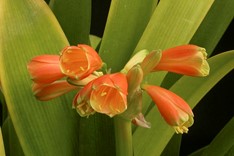
When seeds that are purchased are not specifically labelled, as in “my breeding mix” or else “interspecific hybrid”, it is sometimes difficult to identify the parentage of the resultant plant(s), so in addition to the flower, other features such as the leaf and overall appearance of the plant itself, or the flowering time, may need to be considered. Even then, some plants remain indistinguishable, especially as the number of times C. miniata is used in the cross increases and it becomes more miniata-like in appearance. When identification is still not possible, statements such as “origin unknown” are sometimes used to accompany photos in published texts.
When an interspecific hybrid is named, sometimes the information on its background is not always readily available. Knowing that Rudo Lotter’s ‘Chanèl’, for example, is an F2 C. nobilis x C. miniata is useful information for anyone trying to create a similar cultivar. In this regard, Ken Smith’s “A checklist and register of Clivia cultivar names” becomes an indispensable reference, though not all named plants are recorded here.
General characteristics
After C. x cyrtanthiflora, the most commonly available interspecific group/category available in Australia is probably the combination of C. miniata and C. gardenii. These hybrids are likely to be fast growing, offset readily, flower in winter, and have flowers that may be semi-pendulous, slightly curved and perhaps with green tips on flared tepals. In Melbourne, these interspecifics seem to mainly flower in June and July. Bill Morris’s ‘Flame’ is a large-flowered orange interspecific hybrid of C. miniata and C. gardenii. The late George Hellen in Queensland often used C. gardenii in his interspecific hybridization. Not infrequently, the tepals of the hybrids exhibit green tips, inherited from the C. gardenii parent, but sometimes the green colour can be diffused throughout the tip area. The yellow interspecific ‘Moondrops’ (see photo in Clivia 2 p.39) is one well-known example, among others, from the Wessel/Rudo Lotter family, which has specialised in interspecifics. ‘Moondrops’ is an F2 hybrid of C. gardenii x yellow C. miniata. The interspecific named ‘Gay Delight’(Clivia 8 p.10 where it is misspelt) which was grown from Nakamura seed by Laurens Rijke was on display at our last meeting. It has an attractive multicoloured flower and is thought to be an F2 C. miniata x C. gardenii cross (not a cross with C. caulescens as originally claimed). Shige Sasaki has recently crossed an orange C. miniata with multitepals x C. ‘Heleborus’, an interspecific of unknown which has a slight green centre. The offspring is bronze in colour, with a green centre, and as expected in the F1, does not have multitepals but these should emerge in the F2.
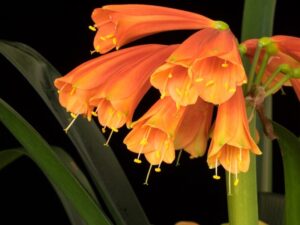
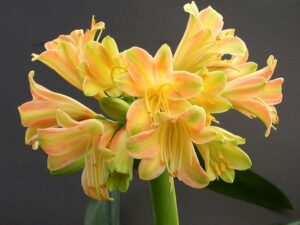
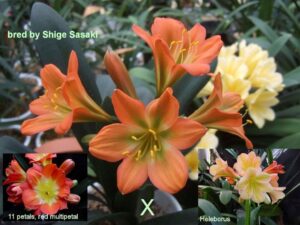
New crosses of C. miniata and C. nobilis tend to be labelled as such. Here, the leaf texture and leaf tips, as well as its floriferous characteristic seem to be strongly influenced by the C. nobilis parent. These hybrids also may inherit some green colouration. The plants often flower in winter and may produce a second flower in another season. ‘Chanèl’, mentioned above, was described by Rudo Lotter as a kind of bicolour, with the outer surface of the tepals being red and the inner surface yellow. I have heard, however, that as the flower ages this distinction is weakened.
Interspecific hybrids of C. miniata and C. caulescens typically flower in July/August in Melbourne, but also may produce flowers at other times, such as summer. At one stage Yoshikazu Nakamura (Japan) bred some extraordinary hybrids, and Laurens Rijke was fortunate in purchasing a good quantity of these seed. Inheriting the large plant form of C. caulescens, the interspecific hybrids may grow into largish plants themselves. Yoshikazu Nakamura’s outstanding cultivar ‘Day Dream’ combines C. miniata and C. caulescens (see below). ‘Mandala’, which is featured on the cover of Duncan’s (2008) publication, is also a hybrid of C. miniata x C. caulescens. ‘Stanmore Moulin Rouge’, another Nakamura hybrid named and owned by Nick Powell (Queensland), is produced from (C. miniata x C. caulescens) x self. Keith Hammett, in New Zealand, has also produced some excellent interspecific hybrids, including ‘Golden Nugget’, a cross of (C. caulescens x C. miniata) x self (see Clivia 9 p.51).
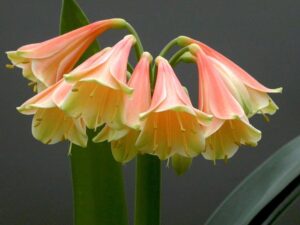
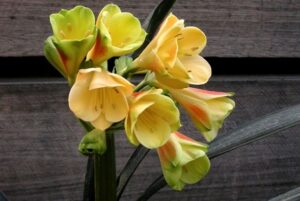
Following the discovery of C. mirabilis in 2001, the South African National Biodiversity Institute (SANBI) has actively been utilizing this new species in a range of interspecific hybrids which first flowered in 2006 (Clivia 9 pp. 47-48; Duncan 2008 p.110-111). C. robusta has also been used in interspecific hybrids by breeders and collectors during the last decade or more.
When we have interspecific hybrids in our collections there will be many observations that we can make. For instance, if an interspecific hybrid produces flowers at different times of the year, we may observe a change in the flower colour across the different seasons or even in different growing situations. This seems to be due to environmental factors, especially the light intensity. In my own experience, the Australian form of C. x cyrthanthiflora can flower regularly in any of the four seasons, and flowers more often than any of the other interspecific hybrid forms. In contrast to C. miniata, many interspecific flowers have a solid colour inside, rather than a contrasting throat colour in the basal area, as tends to be the case with orange-flowering C. miniata.
Breeding interspecifics
While Clivia can be enjoyed either as pot or garden plants, some of us will also be interested in the hybridization of interspecifics. In his introduction of interspecific hybrids, Rudo Lotter (CD or website) indicates that when colour mutations, leaf variations and other genetic variations within the six species are taken into consideration, an endless array of breeding possibilities exist. Quite commonly C. miniata, with its many variations, is used as the seed or mother parent and then crossed with one of the pendulous species, but it is also sometimes used at the pollen parent. Although there are some differences of opinion, it is thought that each parent contributes 50% to the genetic constitution of the offspring (eg Wessel Lotter, Clivia 2 p.34; Johan Spies, Clivia 8 p.35). While inheriting characteristics of both parents, Rudo Lotter claims that a cross between C. gardenii and C. miniata will be more pendulous looking than a cross of C. miniata x C. gardenii. Undertaking a reciprocal cross, where each parent is used as the seed or maternal parent and vice versa is the best way to investigate the differences of using the same parent as the seed or pollen parent. Less commonly, pendulous species are crossed between themselves.
Wessel Lotter indicates that not all interspecifics will be attractive and he himself personally prefers those that are semi-pendulous, semi-open, gracefully curving flowers (Clivia 2, p.40). Different people, nevertheless, appreciate different flower forms and some of us like many different variations.
To maximize the potential of interspecifics, the breeding of more than one generation is necessary. Rudo Lotter, for example, argues that in a first generation cross (F1), such as crossing C. miniata x C. gardenii, the siblings will not exhibit a lot of variation. To bring out further characteristics that are recessive, the best F1 siblings are crossed between themselves (or selfed) to create the F2 generation. It is through this method that we can obtain yellow interspecifics in the second (ie F2) generation.
These days an increasing number of yellow interspecifics are available, but if we wish to breed our own, this can be achieved using a good form of yellow C. miniata and crossing it to one of the other species. By following Wessel Lotter’s (Clivia 2, p.41) example of a step-by-step description of an interspecific hybrid involving C. miniata x C. nobilis, reproduced below, a yellow interspecific will emerge:
(1) Cross C. miniata (yellow) x C. nobilis (or any other species) =
100% F1 orange split (heterozygous for) yellow hybrids.
(2) F1 orange split yellow hybrid x F1 orange split yellow hybrid =
25% F2 yellow hybrids
25% F2 orange hybrids
50% F2 orange split yellow hybrids.
(3) F2 yellow hybrid x F2 yellow hybrid =
100% F2 yellow hybrids.
(Clivia 2 p.41).
In other words, a yellow interspecific hybrid can be achieved in the second generation.
Although it has been suggested that we only need to proceed to the second generation (F2) in interspecific hybridization, Keith Hammett indicates that quite often, recessive traits are not expressed until generations much later than the F2 (personal communication), so there may in fact be reason to proceed to F3 or F4 though sibling crosses or selfing.
Yoshikazu Nakamura’s experience is that excellent interspecfic hybrids can be achieved already by the second generation (F2). He has often selfed his F1 interspecific hybrids, thereby bringing out many attractive features in the flowers of the F2 generation. In selecting parents to hybridize, he pays attention to small features found in the species parent that might be accentuated in the subsequent interspecific hybrid, for example a round tepal in a small pendulous flower. ‘Clementina’, named by Laurens Rijke, is probably the very best cultivar to emerge from Yoshikazu Nakamura’s crossing of (C. miniata x C. caulescens) x self (see Clivia 7, inside cover). Note that if an F1 interspecific (or any other F1 for that matter) is subsequently used in a cross with a different parent, it becomes a new F1.
Main hybridisation patterns
In his classification of interspecific hybrids, Graham Duncan (2008:101) defines primary interspecific hybrids as “first generation hybrids between different Clivia species”. A cross of C. miniata x C. gardenii, or C. gardenii x C. miniata is thus a primary interspecific hybrid. Numerous other examples have been noted above. Given the increasing availability of these primary interspecific hybrids in recent years, these plants are now often being used in new crosses, whether it is with C. miniata or another combination. Graham Duncan refers to such crosses as advanced hybrids, involving hybrids between primary hybrids and species. Where three or more species are involved, Keith Hammett recommends that the term complex hybrid is an appropriate term (personal communication).
Although C. x cyrtanthiflora is already a primary hybrid, it is now often crossed to C. miniata again. Given its widespread distribution in many Clivia-growing countries, it is not surprising to find it used in many new interspecific hybrids. The photo of Lisa Fox’s attractive plant, ‘Felicia’, bred by John Craigie in Queensland and reproduced in the July newsletter and the current website, is yellow C. miniata x C. cyrtanthiflora. Kevin Walters has named another delightful cross of C. x cyrtanthiflora x orange C. miniata as ‘Sakura’. My own crosses using C. x cyrtanthiflora are now beginning to flower and I am interested to see the amount of variation that occurs, particularly based on whether C. x cyrtanthiflora is used as the seed or pollen parent and according to the use of different C. miniata (or other) parents.
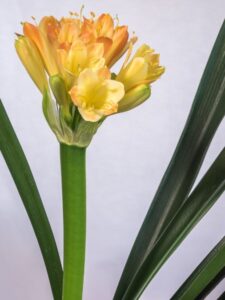
In the May 2009 MCG newsletter (Vol. 2.3), John van de Linde outlined his experiences of undertaking a reciprocal cross of [C. miniata x (C. caulescens x C. miniata)] x C. miniata. He reports obtaining a higher flower count where the interspecific was used as the maternal plant in the cross. Yoshikazu Nakamura’s special cultivar ‘Day Dream’, mentioned above, is a hybrid of (orange C. miniata x yellow C. miniata) x (C. caulescens x yellow C. miniata) (see Clivia 8, pp.13-15; Clivia 9, pp. 49-54). In quite a lot of his hybridization, this breeder has used (orange C. miniata x yellow C. miniata) as one parent, and this also applies to his interspecific hybrids such as ‘Day Dream’ and others.
When backcrossed to C. miniata, the flowers of the interspecific hybrids are characteristically larger in size and sometimes look more C. miniata-like. Laurens Rijke has produced some lovely interspecifics hybrids using Yoshikazu Nakamura’s orange (C. miniata x C. caulescens) x C. miniata ‘Aurea’, achieving a number of highly attractive plants from just one cross, some of which have been named, such as ‘Patsy’, ‘Pansy’, ‘Primrose’ and ‘M. Rose’, displaying a range of different flower shapes and colours. Whereas the majority of primary interspecifics or variations of them seem to flower in Melbourne during June and July, the interspecifics that are crossed back to C. miniata primarily flower during August, thus overlapping with the start of the main C. miniata flowering season itself.
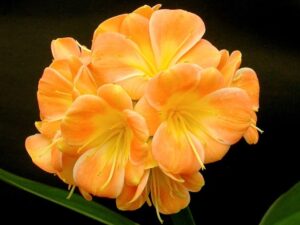
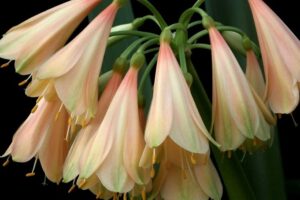
If we wish to retain the predominantly pendulous/semi-pendulous feature of an interspecific, rather than to cross it back to C. miniata, two hybrids of the same type could be crossed together, as in a sibling cross, for example, (C. miniata x C. caulescens) x (C. miniata x C. caulescens). Alternatively, to produce an interspecific hybrid that will carry a variety of different genes and which might flower at different times of the year, one could cross hybrids based on different species, such as (C. gardenii x C. miniata) x (C. caulescens x C. nobilis). Another way is to cross an interspecific hybrid to a single species, as in (C. miniata x C. caulescens) x C. gardenii.
The Queenslander mentioned above, George Hellen, sometimes backcrossed his (C. miniata x C. gardenii) to either C. miniata or to C. gardenii. The cross that I own of ‘Green Imp’ is of the latter type and this may explain the predominance of green in the tip and median section of the flower, since it has C. gardenii twice in its parentage. In 2009 Yoshikazu Nakamura backcrossed some yellow interspecifics (based on C. miniata and C. gardenii) to yellow C. miniata and, as expected, found all green-pigmented seedlings. He planned to cross these yellow interspecifics with (orange C. miniata x yellow C. miniata) the following year and no doubt hoped for some new and different colouration patterns in the resulting flowers.
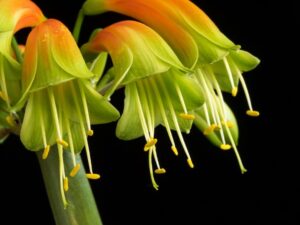
Creating our own interspecific hybrids
It is certainly not difficult to create our own interspecific hybrids. Planning the goals of the hybridization and then selecting suitable parents is a good place to start. This may involve selecting features in the parents that we wish to produce in the offspring.
Since the different species may flower at different times of the year, storing pollen in the refrigerator (or freezer) will probably be necessary, making sure that it is labelled and dated. Pollen might also be available at MCG meetings from time to time. Some people say that pollen will remain viable in the freezer for seven years; kept in the refrigerator, the pollen will certainly last for the season (or year) when it is used but probably up to three years.
Interspecific hybrids with variegation are still relatively unusual, so using a variegated C. miniata would be a good choice for those who like variegates. Crossing interspecifics that we already own back with C. miniata or with another species is also worthwhile. In other words, there are seemingly endless possibilities. It goes without saying that we should keep full records of our crosses.
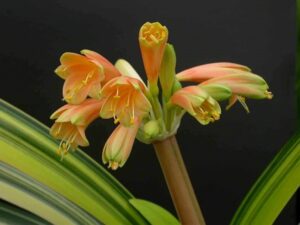
Current and new directions in breeding
It is interesting to speak with breeders about their current work in interspecific hybridization or to view photos of some of the outcomes. We can also examine some of the seed lists that are put out by Clivia growers from around the world to see examples of the crosses that they are currently making. At the forum held in New Zealand in October 2008, Jim Shields suggested that the most interesting developments in Clivia will come from among the serious backyard hybridizer. Although he made this remark in general, it is not hard to envisage that growing and breeding interspecific hybrids is one area where creativity – or sometimes luck? – may have a role. In any case, we can continue to be stimulated by seeing some of the fantastic new crosses arising from hybridization that is being done locally, nationally and internationally.
Websites (as of 2009) to view photos of interspecific hybrids:
My thanks to Keith Hammett for advising on an earlier draft of this text.
References
Duncan, G. (2008) (2nd ed.) Grow Clivias. South Africa: SANBI.
Koopowitz, H. (2002) Clivias. Portland: Timber Press.
Lotter, W.J. (Clivia 2) Advanced hybridising of Clivias. (pp. 34-41)
Marriott, H. (Clivia 8) Nakamura’s contribution to Clivia breeding. (pp.6-18)
Marriott, H. (Clivia 9) Clivia caulescens and its hybrids. (pp.49-54)
Rourke, J. (Clivia 5) Natural interspecific hybrids in Clivia. (pp. 78-80)
Spies, J. (Clivia 8) Genetic aspects of Clivia breeding. (pp.31-38)
Truter, J.T. et al. (Clivia 8) Clivia x nimbicola – a stunning beauty from the Bearded Man. (pp. 23-27)
15/6/2018

